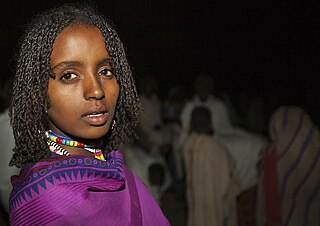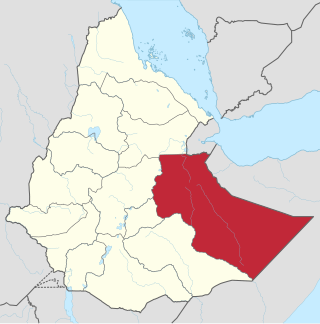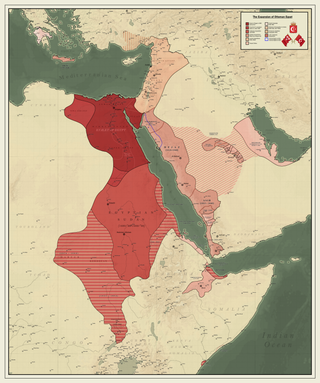Related Research Articles

The Oromo people are a Cushitic ethnic group native to the Oromia region of Ethiopia and parts of Northern Kenya. They speak the Oromo language, which is part of the Cushitic branch of the Afroasiatic language family. They are one of the largest ethnic groups in Ethiopia. According to the last Ethiopian census of 2007, the Oromo numbered 25,488,344 people or 34.5% of the Ethiopian population. Recent estimates have the Oromo comprising 45,000,000 people, or 35.8% of the total Ethiopian population estimated at 116,000,000.

Harar, known historically by the indigenous as Harar-Gey or simply Gey, is a walled city in eastern Ethiopia. It is also known in Arabic as the City of Saints.

RasMakonnen Wolde Mikael Wolde Melekot, or simply Ras Makonnen, also known as Abba Qagnew, was an Ethiopian royal from Shewa, a military leader, the governor of Harar, and the father of future Emperor Haile Selassie. Described by Nikolai Gumilev as “one of the greatest leaders of Abyssinia”, he served in the First Italo-Ethiopian War, playing a key role at the Battle of Adwa.

Dire Dawa is a city in eastern Ethiopia near the Somali Region and Oromo border and one of two chartered cities in Ethiopia. Dire Dawa alongside present-day Sitti Zone were a part of the Dire Dawa autonomous region of the Somali Region stipulated in the 1987 Ethiopian Constitution until 1993 when it was split by the federal government into a separately administered chartered city.

Hararghe was a province of eastern Ethiopia with its capital in Harar.
Barento is one of the two major subgroups of the Oromo people, a Cushitic ethnic group. They live in the West Hararghe Zone, East Hararghe Zone, Arsi zone, of the Oromia Region of Ethiopia while the other subgroup named Borana Oromo inhabiting Oromia Special Zone Surrounding Addis Ababa, West Shewa Zone, West Welega Zone and Borena Zone of the Oromia Region of Ethiopia.
Sheikh Abaadir Umar Al-Rida, also known as Aw Abadir or Aw Badir was the legendary founder of Harar and a patron saint in modern-day eastern Ethiopia. The modern Harari people regard him as their common ancestor, as does the Somali Sheekhal clan.
Fedis is a woreda in Oromia Region, Ethiopia. Part of the East Hararghe Zone, Fedis is bordered on the southwest by Garamulleta zone, Meyumuluke woreda, on the west by Girawa, on the northwest by Haro Maya, on the north by the Harari Region, on the east by Babille, and on the southeast by the Erer River which separates it from the Somali Region at south by Midega tola district. The administrative center of this district is Boko.
Meta is one of the districts in the Oromia of Ethiopia. Part of the East Hararghe Zone, Meta is bordered on the southwest by Deder, on the northwest by Goro Gutu, on the north by the Somali Region, on the northeast by Kersa, and on the southeast by Bedeno. Towns in Meta include Chelenqo and Kulubi.

The Karanle are a Somali clan, forming one of the six branches of the larger Hawiye clan. The Karanle are geographically spread out across three countries: Somalia, Ethiopia, and Kenya. Among all of the Karanle inhabited regions of the Horn of Africa, Ethiopia is the where the majority of the clan reside. In Ethiopia, the Karanle are mainly found in Harar, Hubat, and Babile but they also inhabit the Somali Region, Dire Dawa and surrounding regions. The majority of the Karanle Sub-clans predominantly reside in the regions of Ethiopia where the Somali population is predominant, with the exception of the Murusade Sub-clan, who reside in central and southern Somalia.
The Argobba are an ethnic group inhabiting Ethiopia. A Muslim community, they are spread out through isolated village networks and towns in the north-eastern and eastern parts of the country. Group members have typically been astute traders and merchants, and have adjusted to the economic trends in their area. These factors have led to a decline in usage of the Argobba language. Argobba are considered endangered today due to exogamy and destitution as well as ethnic cleansing by the Abyssinian state over the centuries.

The Harari people are a Semitic-speaking ethnic group which inhabits the Horn of Africa. Members of this ethnic group traditionally reside in the walled city of Harar, simply called Gēy "the City" in Harari, situated in the Harari Region of eastern Ethiopia. They speak the Harari language, a member of the South Ethiopic grouping within the Semitic subfamily of the Afroasiatic languages.
The Harla, also known as Harala, Haralla are an ethnic group that once inhabited Ethiopia, Somalia, and Djibouti. They spoke the now-extinct Harla language, which belonged to either the Cushitic or Semitic branches of the Afroasiatic family.

The Makhzumi dynasty also known as Sultanate of Shewa or Shewa Sultanate, was a Muslim kingdom in present-day Ethiopia. Its capital Walale was situated in northern Hararghe in Harla country. Its territory extended possibly to areas west of the Awash River. The port of Zeila may have influenced the kingdom. The rise of the Makhzumi state at the same time resulted in the decline of the Kingdom of Axum. Several engravings dating back to the 13th century showing the presence of the kingdom are found in Chelenqo, Bale, Harla near Dire Dawa and Munesa near Lake Langano.

The Emirate of Harar was a Muslim kingdom founded in 1647 when the Harari people refused to accept Imām ʿUmardīn Ādan as their ruler and broke away from the Imamate of Aussa to form their own state under `Ali ibn Da`ud.
The Jaarso, Giarso or Jaarsoo is a northern Somali clan, a sub-division of the Dir clan family They largely live in Ethiopia, in the Oromo Region and the Somali Region, especially in and around the ancient cities of Chinaksen, Harar and Jigjiga
Chercher was a province in Hararghe now part of Oromia Region, Ethiopia. Also known as Ittuu and West Hararghe, Chercher is the name given mainly to the eastern escarpment highland areas of Oromia state's West Hararaghe Zone, where the chains of Checher or higher mountains rise and extend inland from the Great Rift Valley in its northwest. The capital of the former Chercher province was Chiro.
The Oromo–Somali clashes flared up in December 2016 following territorial disputes between Oromia region and Somali region's Government in Ethiopia. Hundreds of people were killed and more than 1.5 million people fled their homes. The conflict ended in 2018.

Hubat, also known as Hobat, or Kubat was a historical Muslim state located in present-day eastern Ethiopia. Historically part of the Adal region alongside Gidaya and Hargaya states on the Harar plateau. Hubat is today within a district known as Adare Qadima which includes Garamuelta and its surroundings in Oromia region. The area is 30 km north west of Harar city at Hubeta, according to historian George Huntingford. Trimingham locates it as the region between Harar and Jaldessa. Archaeologist Timothy Insoll considers Harla town to be Hubat the capital of the now defunct Harla Kingdom.

The Egyptian invasion of the Eastern Horn of Africa, namely Hararghe and western Somaliland, was part of a conflict in the Horn of Africa between the Sultan of Aussa, and Oromo tribesmen, and the Khedivate of Egypt from 1874 to 1885. In 1874, the Egyptians invaded Eastern Ethiopia, namely Hararghe and western section of Somaliland, and ruled it for 1 year.
References
- ↑ Ficquet, Éloi. Ḥabeš Siyāḥatnāmesi: The Journey of al-Mu'ayyad al-'Azm in Ethiopia (1904). Centre français des études éthiopiennes.
- ↑ Mohammed, Asmea (2023). "Distribution and association of common leaf rust (Puccinia sorghi Schwein) and turcicum leaf blight [Exserohilum turcicum (Pass.)] of Maize (Zea mays L.) with biophysical factors in Eastern Ethiopia". Agrosystems, Geosciences & Environment. 6 (3). Haramaya University. doi:10.1002/agg2.20407.
- ↑ GIANFRANCESCO, LUSINI. LINGUE DI CRISTIANI E LINGUE DI MUSULMANI D'ETIOPIA. EDIZIONI DI STORIA E LETTERATURA. p. 136.
- ↑ Problemi attuali di scienza e di cultura quaderno. Accademia nazionale dei Lincei. 1947. p. 730.
- ↑ Tibebu, Teshale (1995). The Making of Modern Ethiopia 1896-1974. Red Sea Press. p. 43. ISBN 978-1-56902-001-2.
- ↑ Chelenqo. Encyclopedia Aethiopica.
- ↑ Fombad, Charles (2024). Constitutional Identity and Constitutionalism in Africa. Oxford University Press. p. 128. ISBN 978-0-19-890630-8.
- ↑ Lindahl, Bernhard. Local History of Ethiopia (PDF). Nordic Africa Institute. p. 9.
- ↑ "Ethiopia – Ethnic Violence Out of Control". Africa Research Bulletin: Political, Social and Cultural Series. 54 (12). Wiley-Blackwell. 2018. doi:10.1111/j.1467-825X.2018.08035.x.
9°23′53″N41°33′39″E / 9.39806°N 41.56083°E